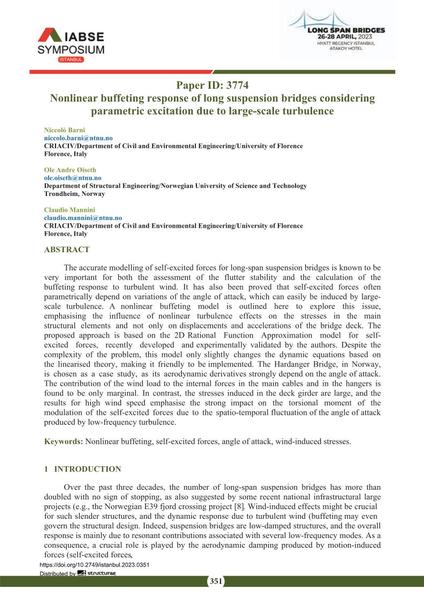Nonlinear buffeting response of long suspension bridges considering parametric excitation due to large-scale turbulence

|
|
|||||||||||
Bibliographic Details
| Author(s): |
Niccolò Barni
(CRIACIV/Department of Civil and Environmental Engineering/University of Florence Florence, Italy)
Ole Andre Øiseth (Department of Structural Engineering/Norwegian University of Science and Technology Trondheim, Norway) Claudio Mannini (CRIACIV/Department of Civil and Environmental Engineering/University of Florence Florence, Italy) |
||||
|---|---|---|---|---|---|
| Medium: | conference paper | ||||
| Language(s): | English | ||||
| Conference: | IABSE Symposium: Long Span Bridges, Istanbul, Turkey, 26-28 April 2023 | ||||
| Published in: | IABSE Symposium Istanbul 2023 | ||||
|
|||||
| Page(s): | 351-358 | ||||
| Total no. of pages: | 8 | ||||
| Year: | 2023 | ||||
| DOI: | 10.2749/istanbul.2023.0351 | ||||
| Abstract: |
The accurate modelling of self-excited forces for long-span suspension bridges is known to be very important for both the assessment of the flutter stability and the calculation of the buffeting response to turbulent wind. It has also been proved that self-excited forces often parametrically depend on variations of the angle of attack, which can easily be induced by large-scale turbulence. A nonlinear buffeting model is outlined here to explore this issue, emphasising the influence of nonlinear turbulence effects on the stresses in the main structural elements and not only on displacements and accelerations of the bridge deck. The proposed approach is based on the 2D Rational Function Approximation model for self-excited forces, recently developed and experimentally validated by the authors. Despite the complexity of the problem, this model only slightly changes the dynamic equations based on the linearised theory, making it friendly to be implemented. The Hardanger Bridge, in Norway, is chosen as a case study, as its aerodynamic derivatives strongly depend on the angle of attack. The contribution of the wind load to the internal forces in the main cables and in the hangers is found to be only marginal. In contrast, the stresses induced in the deck girder are large, and the results for high wind speed emphasise the strong impact on the torsional moment of the modulation of the self-excited forces due to the spatio-temporal fluctuation of the angle of attack produced by low-frequency turbulence. |
||||
| Keywords: |
self-excited forces Nonlinear buffeting angle of attack wind-induced stresses
|
||||
